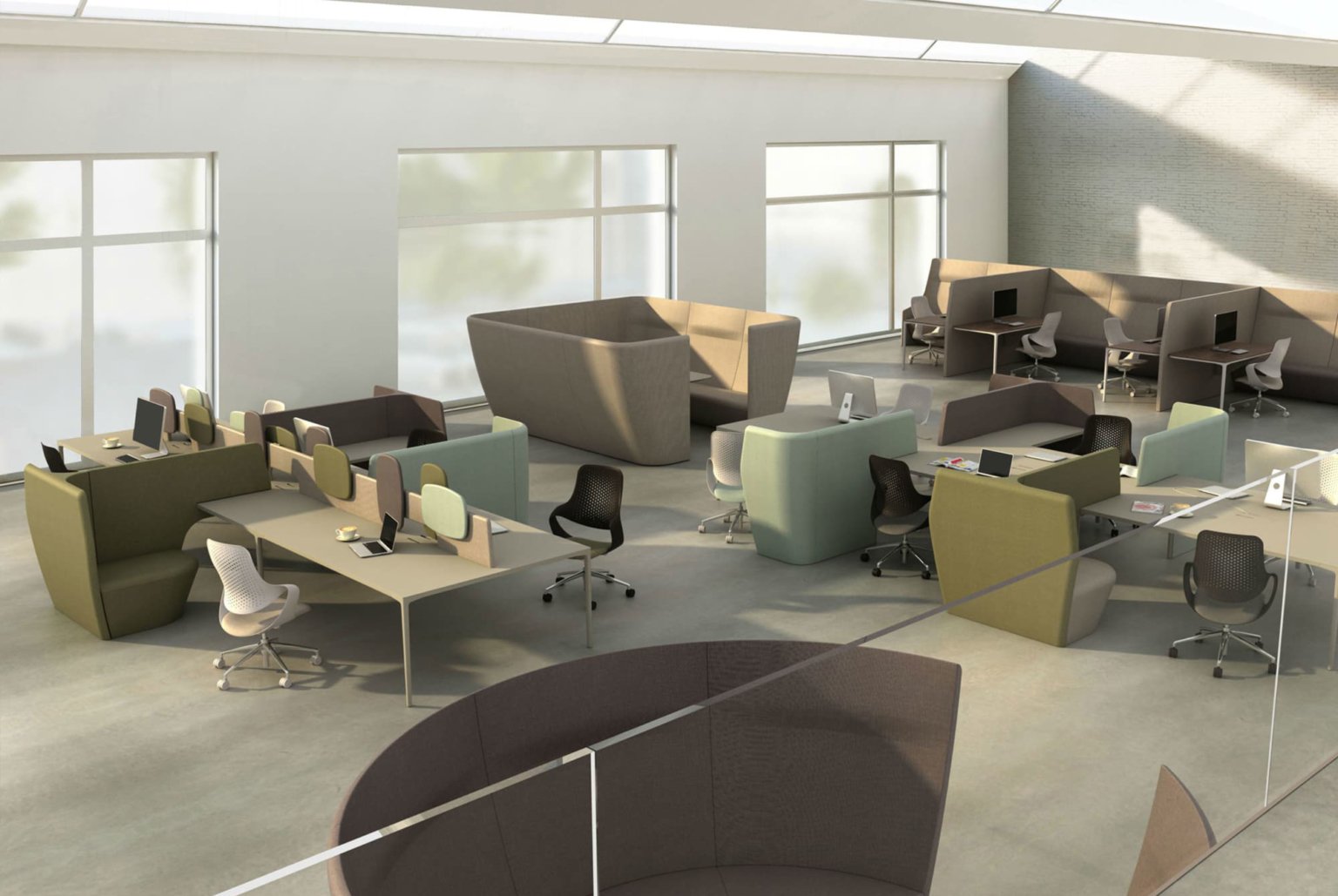What is Modern Commercial Office Furniture?

What is Modern Commercial Office Furniture?
Modern and contemporary design… What’s the difference when it comes to commercial office furniture? The words “modern” and “contemporary” get used interchangeably when referring to what’s happening right now, in the present — for example, “contemporary fiction” and “modern love.” Let’s clear this up and help decide between contemporary or modern style designs for your commercial office furniture.
When referring to art and design, there is a significant difference between modern and contemporary.
The word “modern” – as we use it in the design world – derives from the Modern art movement, spanning between the 1860s to 1970s. During that time, artists explored fresh approaches to seeing and comprehending nature and art functions. Think about the works of Monet, Manet, Matisse, and Picasso, and you’ll get the idea.
Some of the features that define this style are:
- Functional: adheres to architect Louis Sullivan’s philosophy – “Form follows function.”
- Simplistic: Ornate elements are seldom used, if at all.
- Geometric: Uses basic shapes for sleek edges and clean lines.
- Organic: Uses shapes found in nature that usually to lead to soft curves.
- Diverse: Embraces a large variety of materials and colors
Characteristics of commercial office furniture design — especially when considering mid-century modern — will include the same clean lines and unembellished structures, and are often made from natural materials like wood, leather, and teak, although plywood, polished metals, and plastic were also used.
Modern Commercial Office Furniture Design
Modern office furniture design refers to style from a particular era in time. Specifically, to the styles of the early to mid-twentieth century – notably, the 1920s through to the 1950s. Therefore, the modern design never changes. It captures and celebrates the mood and style of a specific era.
While these periods can include anything from art deco to Bauhaus, mid-century modern is considered the crown jewel of modern interior design.
Modern office furniture design was often open and raised off the ground, which lent a light, airy feeling.
A few iconic examples of modern furniture design would include the work of Vladimir Kagan, whose pieces evoked natural forms made from wrought iron, cast aluminum, and sculpted wood. Or, the Eames chair, which is an elegantly curving lounge chair and ottoman crafted from molded plywood and leather.
Contemporary Commercial Office Furniture Design
On the other hand, contemporary design literally means “of the present” and referring to the latest trends. Contemporary artists and designers are those who live and work today.
Contemporary office furniture design is about the here and now. It shows what’s happening in today’s world of office furniture design. It’s continually evolving and toys with conventions, embracing new ideas. It takes different forms as the seasons turn.
Sometimes Modern and Contemporary Commercial Office Furniture are the Same
In short, ‘Modern’ refers to a design from a specific period in time, and what is now considered modern will always be modern. ‘Contemporary’ is referring to what’s happening now, and what we call contemporary today will not be contemporary twenty years from now.
That said, the modern design movement is presently having a moment, and it’s, therefore, accurate to say that modern style is also part of contemporary style, for the moment. This time around, modern style gets an update when combined with pieces that reflect international influence and other eclectic tastes.
Mid-Century Modern Commercial Office Furniture
Mid-century modern is considered one of the most prestigious and sophisticated styles of interior design. This aesthetic is famous for its clean lines, open concepts, and minimal decoration. Mid-century modern is all about the beauty of simplicity. An uncluttered atmosphere gives more prominence to the modern style architecture making its mid-century style furniture the focal point of the space.
Mid-Century Modern design colors
The mid-century design philosophy is famous for its use of vibrant colors. It often embraces shades like mustard yellow, tangerine, aqua, fire engine red, and olive green. However, these attention grabbers won’t do it alone. Tones of brown, gray, and white are used to ground the design, contrast any colorful accents, and cultivate the design’s signature style.
Wood furniture is one simple way that Mid-Century Modern design incorporates earthier shades. Not only can wood help achieve a perfect balance within a space, but wooden Mid-Century Modern furniture is available in a variety of hardwoods. Each of which offers its own style and benefits.
Influences of Modern Design in Commercial Office Furniture
Open-concept office plans
There has been a massive resurgence of open-concept spaces in recent years, and you can thank mid-century modern corporate office furniture! This style is the godfather of the open-concept office space. Having fewer walls allows a smoother flow from room to room, giving you more freedom to experiment with furniture placement. It makes any space feel significantly larger.
Solid angles and lines
This style prides itself on sleek lines, distinct angles, and geometric shapes in everything from mid-century modern architecture to office furniture and works of art. Asymmetry is also a prominent feature of mid-century design.
Fewer furniture pieces
Empty spaces can be just as effective as full ones. Having fewer furniture pieces highlights the mid-century idea of simple living. With this style, less is more!
White walls
Mid-century spaces feature white walls to keep things fresh and make their furnishings and architectural details pop! White-colored walls also transcend trends and seasons, so your office will always look airy and feel current. Again, it’s all about simple, elegant sophistication.
Natural materials
Modern design always incorporates natural elements to make the area warmer and more welcoming. This might be wood, wool, leather, linen, and polished metals. Modern style developed in a period that embraced manufacturing and industry, so pieces made from molded plastic and plywood were fashionable choices in mid-century furniture.
Lots of windows
One of the essential philosophies behind mid-century modern design is establishing a connection with nature. Designing a space with large windows (and many of them) was a crafty way to marry indoor and outdoor spaces – not to mention providing a great deal of natural light!
It all comes down to this –modern design is all about a style in a specific moment in time. Contemporary design is about the present moment. Modern is, at the moment, contemporary, but so are other styles. Whatever style speaks to you, both modern and contemporary will leave a lasting impression.
Written by:
John Ofield
President/CEO at Collaborative Office Interiors
Collaborative Office Interiors is a complete office furniture and systems provider in the Houston, Austin and San Antonio area. COI specializes in providing high quality/low-cost solutions to companies that are moving, upgrading or expanding.
John opened ROSI Office Systems in 1993 and the company today is on Inc. Magazines’ Top 5000 Fastest Growing Companies in 2018. John specializes in new office furniture, space planning, new workstations, Work Fit products, remanufactured Haworth cubicles, asset management, furniture liquidation, and office furniture rentals.

John Ofield is the owner of Collaborative Office Interiors. Houston’s trusted source for premium office furniture, office cubicles, demountable walls, office desks and tables, and complete workspace solutions. With more than 40 years of experience, he combines deep product knowledge with hands-on space-planning expertise to create ergonomic, productivity-focused work environments for businesses across Southeast Texas.

